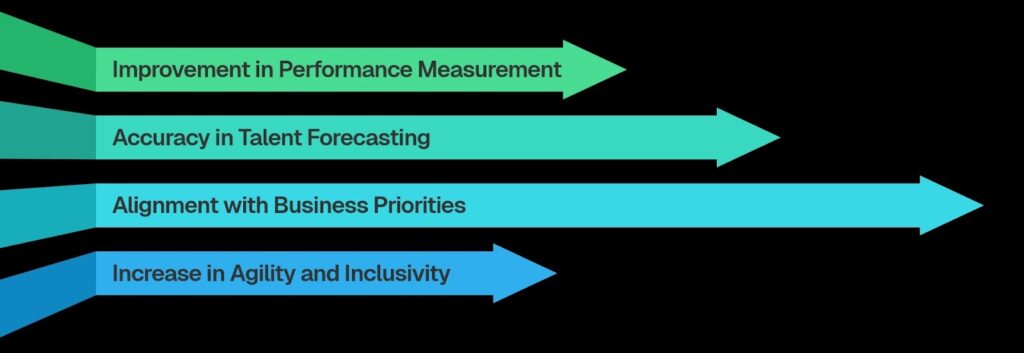Workforce Analytics Is No Longer Optional for Enterprise HR, data powers everything—from supply chain optimization to marketing spend. But one area where data is now making a massive impact is workforce planning and HR strategy. As organizations look to grow smarter, not just bigger, workforce analytics software is becoming a central part of decision-making across the enterprise.
This isn’t just about tracking headcount or churn anymore. Today’s HR leaders and analysts are being asked to answer tough questions: What’s driving performance? Where are the hidden skill gaps? Are we overinvesting in roles that don’t deliver ROI? What’s our readiness for future talent needs?
The answers to these questions are buried in workforce data. With the right analytics tools, companies can uncover insights that improve performance, guide hiring, reduce costs, and align talent with strategy. This article will walk through how workforce analytics software is shaping modern enterprise decisions—and how platforms like JobsPikr are helping HR teams stay ahead of the curve.

The Rise of Workforce Analytics in Strategic Planning
Just a few years ago, HR data was used mostly for compliance reporting or historical reviews. But now, we’re seeing a fundamental shift. More and more companies are using workforce analytics not just to look backward, but to guide what happens next.
Why the shift?
Because workforces are becoming more complex. Remote and hybrid teams, global operations, diverse skills, and a fast-changing business environment all make workforce planning harder than ever. To stay agile, companies need real-time answers and predictive insights. That’s what workforce analytics software delivers.
HR technology leaders are now building dashboards that track key workforce metrics in real time—things like talent utilization, role performance, internal mobility, attrition risk, and leadership pipeline strength. These insights are helping businesses:
- Make faster, data-informed decisions
- Prevent talent shortages and over-hiring
- Align workforce priorities with financial goals
- Improve employee engagement and development
In fact, according to a 2023 Deloitte study, 84% of high-performing companies say workforce analytics is “critical” or “very important” to their long-term strategy. That number is only growing.
How Workforce Analytics Software Works (and Why It’s Different from Traditional Reporting)
Not all data tools are created equal. While traditional HR reporting focuses on historical metrics like turnover or hiring numbers, workforce analytics software takes things further.
It pulls data from multiple HR systems—recruiting, performance, learning, compensation, and more—and brings it together into one dashboard. From there, advanced analytics and AI models analyze trends, identify patterns, and offer predictive insights. These can include:
- Who’s likely to leave and why
- Which skills are becoming critical across business units
- Which roles generate the highest business impact
- Where internal promotions are succeeding—or falling short
This level of analysis helps companies shift from reactive to proactive planning. Instead of waiting for issues to arise, HR teams can anticipate them and take action early.
JobsPikr enhances this capability by adding external labor market data into the mix. So while internal systems show what’s happening inside your walls, JobsPikr shows what’s happening across the industry, giving you a full 360-degree view for smarter, more confident decisions.
Forecasting Talent Needs with Greater Accuracy
One of the biggest values of workforce analytics is in forecasting. HR teams have always tried to predict hiring needs, but without robust data, those forecasts are often based on guesswork or simple year-over-year projections.
With modern workforce analytics software, forecasting becomes much more scientific.
By analyzing historic hiring trends, role performance, skills data, and growth plans, analytics platforms can predict when and where you’ll need to hire. They can also flag which teams are likely to experience turnover, which roles are underutilized, and where internal talent could fill future gaps.
This is a game-changer for capacity planning. It allows HR leaders to:
- Model different growth scenarios based on business priorities
- Align workforce strategy with new product launches or market entries
- Avoid costly hiring sprees that later lead to redundancies
- Ensure that talent pipelines are always future-ready
JobsPikr supports this predictive capability by providing current and historical job market trends across industries and geographies. This helps HR teams understand external shifts in demand so they can plan their internal workforce strategy with confidence.
Measuring and Improving Performance at Every Level
Understanding workforce performance used to rely mostly on manager feedback or once-a-year reviews. Today, with the help of HR analytics software, enterprises can assess performance in a much more structured and data-backed way.
Here’s how:
Workforce analytics platforms combine performance scores, productivity data, engagement surveys, and even learning metrics to build a comprehensive view of each team or role. This helps identify:
- Which roles contribute most to key business metrics
- Where coaching or training is having the greatest impact
- What patterns lead to high performance or disengagement
With this information, organizations can build targeted performance improvement plans, reward high-impact contributors more effectively, and design roles that are more aligned with business goals.
This kind of insight also supports better leadership development. When you know what traits and career paths lead to strong outcomes, you can scale them across your organization.
Supporting Agile and Inclusive HR Strategies
Agility in HR means being able to pivot your strategy quickly, whether that’s shifting from hiring to reskilling or adapting to new business goals without disrupting workforce morale.
Workforce analytics helps make this possible.
Let’s say your company is going through a digital transformation. You may need to quickly understand:
- Which employees already have digital skills and could be retrained
- Which locations have the highest density of relevant talent
- How fast do you need to hire vs. build internal capabilities
Instead of relying on broad assumptions, workforce analytics software gives you exact answers. This helps you make faster, better decisions with less risk.
At the same time, workforce data plays a major role in making HR more inclusive. By tracking metrics like promotion rates by gender or pay gaps across roles, analytics tools reveal hidden biases. That visibility is the first step toward equity, and more companies are using these insights to build fairer, more inclusive organizations.
Integrating Workforce Analytics into Broader Enterprise Systems
To maximize the value of workforce insights, they need to be connected to the rest of the business. That’s why integration is a critical feature of any modern workforce analytics software.
Leading companies are now connecting HR data with finance, operations, sales, and business planning tools. This ensures that decisions around headcount, compensation, and skills development are made in sync with budget constraints, sales forecasts, and strategic priorities.
Here’s what this looks like in practice:
- Finance can model workforce costs more accurately for quarterly planning
- Sales teams can forecast productivity based on account manager loads
- Operations can staff up in regions where production is ramping
This cross-functional alignment improves planning, reduces silos, and ensures that workforce strategy is always aligned with the business at large.
JobsPikr plays an essential role here by providing external benchmarks that feed into these systems. Whether you’re validating a compensation model, identifying talent hubs, or planning international expansion, having up-to-date labor market data brings a new layer of clarity.

Percentage improvement across key business metrics
Making the Case for Investment in HR Analytics Software
Despite the clear benefits, some organizations still hesitate to invest in workforce analytics tools. Common objections often center on perceived high costs, fears of technical complexity, and the challenge of managing organizational change.
But here’s the critical truth: The cost of inaction – relying on gut feel, fragmented spreadsheets, or outdated reports – is exponentially higher. When critical people decisions are made without accurate, integrated, and timely data, organizations face significant and measurable risks:
Low Managerial Effectiveness: Lack of insight into team performance, engagement, and development needs leaves managers flying blind, impacting overall productivity and morale.
Costly Hiring Mistakes: Overhiring inflates payroll and overhead, while hiring for the wrong roles (or the wrong people) leads to wasted recruitment spend, lower productivity, and potential re-hiring costs – often reaching 1.5-2x the position’s salary for a mis-hire.
Preventable Talent Loss: High-potential employees leave silently because early warning signs (disengagement, lack of development, flight-risk scores) go unnoticed. Replacing them costs significantly more than retaining them and drains institutional knowledge.
Strategic Skill Gaps: Falling behind in critical emerging skills (e.g., AI, data science, sustainability) hampers innovation and competitive advantage. Analytics proactively identifies these gaps before they stall projects or market opportunities.
Misaligned Workforce & Financial Planning: Budgets set without understanding true workforce needs lead to either crippling underinvestment in key areas or wasteful overspending in others, impacting EBITDA and strategic agility.
Ineffective Diversity, Equity & Inclusion (DEI) Efforts: Without data, DEI initiatives are guesswork. Analytics reveals true representation gaps, pay inequities, and barriers to inclusion, enabling targeted actions with measurable impact.
The Compelling ROI: Beyond Cost Savings to Strategic Value
The return on investment (ROI) for workforce analytics software isn’t just about cutting costs; it’s about enabling smarter decisions, driving proactive strategies, and unlocking tangible business outcomes:
- Reduce Attrition: Identify flight risks early and implement targeted retention strategies. *Example: A 20% reduction in regrettable attrition in high-value roles can save millions annually.*
- Optimize Recruitment: Shorten time-to-hire, improve quality-of-hire, and reduce cost-per-hire by focusing sourcing and screening efforts using data. Example: Analytics can pinpoint the most effective sourcing channels and predict candidate success factors.
- Boost Productivity & Performance: Align skills to roles, identify top performers and their drivers, and target development where it has the highest impact. Example: Correlate engagement data with performance metrics to understand what truly drives results.
- Enhance DEI Outcomes: Move from intention to measurable action by tracking representation, pay equity, promotion rates, and inclusion survey results. Example: Prove the business impact of diversity through data linking diverse teams to innovation metrics.
- Improve Workforce Planning Accuracy: Forecast future talent needs (skills, locations, headcount) aligned precisely with business strategy and financial projections. Example: Model scenarios for growth, restructuring, or market shifts to optimize workforce strategy.
- Mitigate Compliance Risks: Proactively identify potential issues related to overtime, fair labor practices, or pay equity before they escalate into costly lawsuits or reputational damage.
Final Thoughts: From HR Reports to Strategic Workforce Intelligence
The role of HR is evolving fast. From supporting business operations to driving transformation, today’s HR teams are at the center of enterprise strategy. But to lead in this new era, they need data, not just dashboards, but actionable intelligence.
Workforce analytics software is the engine that makes this possible.
It helps HR leaders and analysts uncover insights, solve challenges, and shape the future of work with clarity and confidence. When paired with external tools like JobsPikr, which offer labor market intelligence and competitor benchmarks, these platforms become even more powerful.
If you’re ready to turn your workforce data into a strategic advantage, sign up on JobsPikr. Our platform gives you the labor market visibility and integrated analytics you need to plan smarter, respond faster, and lead with insight—no matter where your business is headed.



